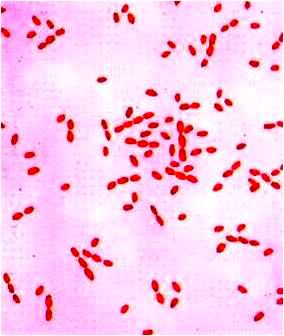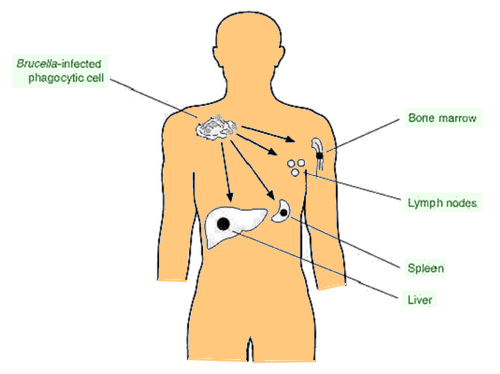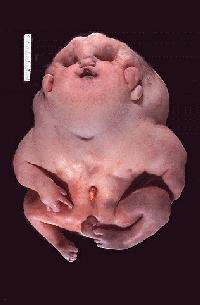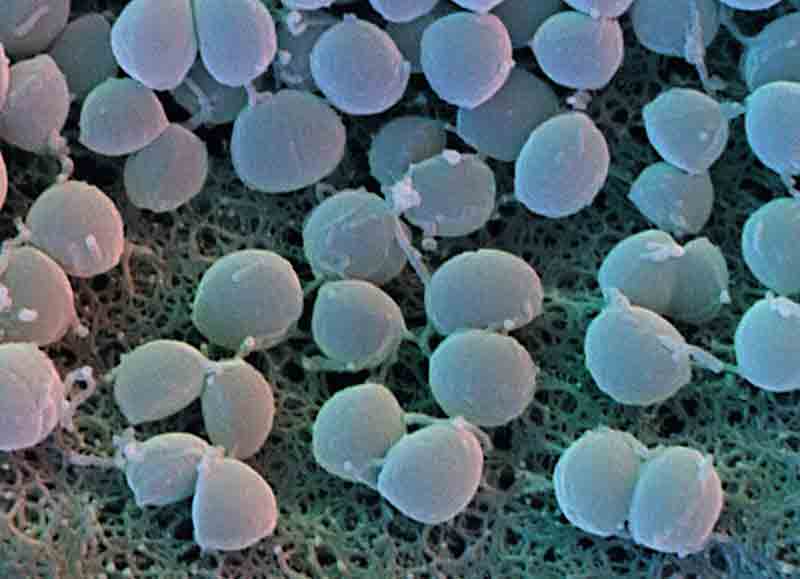Brucella and Brucellosis

Brucella sp. causes brucellosis (also called as Bang’s disease in cattle, named for Bernhard Bang & Sir David Bruce who discovered Brucella and called as undulant fever in humans), a “zoonotic disease endemic in many areas of the world, characterized by chronic infections in animals leading to abortion and infertility, and a systemic, febrile illness in humans”. The genus Brucella consists of 6 species, 4 of which causes human brucellosis. They are facultative intracellular organisms and are named based on the animal they infect:
- Brucella melitensis (goats)
- Brucella abortus (causes abortions in cows)
- Brucella suis (pigs)
- Brucella canis (dogs)
Under the name Malta fever, the disease now called brucellosis first came to the attention of British medical officers in the 1850s in Malta during the Crimean War.
Morphology
- Small (0.5-0.7 × 0.6-1.5μm), gram negative, non-motile, non-capsulate, non-sporing coccobacilli
- Arranged singly or in short chains

Culture
Strict aerobes
Fastidious and nutritional requirement are complex
Grow best in medium enriched with glucose and animal serum
The optimum temperature is 37°C and pH 6.6 to 7.4
Addition of 5-10% CO2 improves the growth of B. abortus and B. melitensis
Addition of bacitracin, polymyxin or cycloheximide makes media selctive for brucellae
Biochemical reactions
Do not ferment carbohydrate
Catalase positive, oxidase positive and urease positive
Reduce nitrate to nitrites
Citrate, MR, VP negative and do not produce indole
Antigenic structure:
2 main somatic antigens: A and M
The 3 main Brucella differ from one another in the amount of the 2 main antigen they have in common :
- B.abortus (A:M=20:1)
- B.melitensis (A:M=1:20)
- B.suis (A:M=2:1)
Antigenic cross reaction occurs between brucella and vibrio cholerae
Virulence factors:
Ability to resist phagocytosis: certain low molecular weight substance present on bacterial surface inhibit fusion of lysosomal granules with the phagosome.
Ability of intracellular survival: elimination of organism by the immune system and treatment with antibacterial agents is difficult and complicated
Tropism for erythritol (a sugar found in animal placentas)
Pathogenesis
- Humans acquire Brucella from direct contact with infected animal meat or aborted placentas, or ingestion of infected milk products.
- These bacteria are very virulent and are able to penetrate any body area they touch. This can occur on the skin following an animal bite, or direct contact with an animal. This can also occur in the lungs after inhalation of infected aerosolized matter.
- Brucella penetrates the skin, conjunctiva, lungs, or GI tract.
- The bacteria are phagocytosed by macrophages. They can survive and grow inside the macrophages and so are facultative intracellular organisms.
- They migrate to the regional lymph nodes, set up infection there, and then move to the:
Clinical Manifestations:
Incubation period: 3-16 days
Latent infection:
Infection is serological positive but there is no clinical evidence.
Acute brucellosis (influenza like syndrome) :
- Undulant fever (usually peaks in the evening and slowly returns to normal by morning)
- Headache
- Limb and back pains are unusually severe, night sweating and fatigue are marked
- Anorexia, weakness, loss of weight, depression
Subacute brucellosis:
- It may follow acute brucellosis.
- Blood culture is less frequently positive.
- Skin test is positive.
Chronic brucellosis:
- It is usually non bacteremic.
- Blood culture is rarely positive.
- Skin test and agglutination are strongly positive.
- There is lassitude sweating and joint pain.
Complications:
Arthritis, meningitis, spondylitis, uveitis, orchitis
Brucellosis as an occupational hazard
Farmers and their families, abattoir workers, butchers and veterinarians are particularly at risk
Infected animals that have recently aborted or given birth present the greatest hazard
Laboratory Diagnosis
Specimen:
- Blood
- Urine, sputum, breast milk
- Lymph node biopsy
- Bone marrow aspirate
Microscopy is insensitive
Culture and isolation:
Liver infusion or glucose serum broth or trypticase soya broth: Atleast 10 cc blood or biopsied material is cultured in a bottle of liver infusion or glucose serum broth or trypticase soya broath and incubated at 37 c under 5-10% CO2. Subcultures are made on liver infusion agar or trypticase soya agar every 3-5 days.
Castaneda’s method: Castaneda’s media provides both liquid (liver infusion broth) and solid media (3% nutrient agar slope) in one bottle. Since the bottle contains both liquid and solid media, the broth flows over the surface of agar slant when bottle is tilted resulting in automatic subculture.
Bactec: The BACTEC MYCO/F LYTIC (MFL) medium has been recently developed to improve the recovery of intracellular pathogens such as fungi and mycobacteria. Because brucellae are facultative intracellular pathogens, its use also improve the diagnosis of brucellosis.
Identification:
- Requirement of CO2 for growth
- Production of urease and H2S
- Sensitivity to the aniline dyes: fuschin, thionine (B. melitensis is not inhibited by any one of the dyes, whereas B. abortus is inhibited by thionine and not by fuschin and B. suis is inhibited by fuschin but not by thionine)
- Agglutination with monospecific sera
- Phage typing: One of the strain phage is Tb. Tb is specific as it lyses strains having character of Brucella abortus.
Serology:
Standard agglutination test (SAT): Diluted serum of patients is tested by slide or tube mthod against a brucella suspension. Both IgM and IgG continue to rise during acute stage of infection. A presumptive diagnosis can be made when there is 4 fold rise in the titre or a single titre greater than 80.
Prozone phenomenon: absence of agglutination in low dilution of serum due to high concentration of antibodies
ELISA and RIA: can distinguish IgM, IgG and IgA brucella specific antibodies
Brucellin test (Skin test): Positive reaction shows an area of erythema and induration of 6 mm diameter within 24 hours.
Detection of animal infection is performed through milk ring test in which brucella agglutinins are detected in the milk of infected dairy cattle. A positive test shows a blue line above the white skim-milk.
Treatment
Tetracycline
Streptomycin + tetracycline
Rifampicin + doxycycline
Prophylaxis
Pasteurization of milk
Immunization of cattle with live attenuated strain of Brucella abortus





